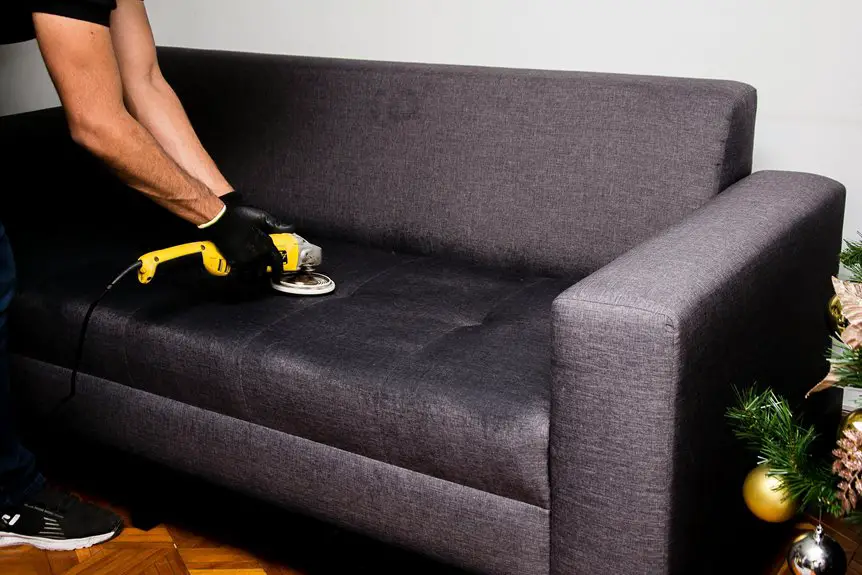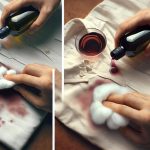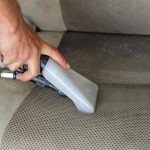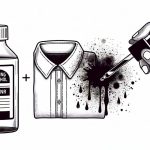You’ll find several effective DIY upholstery cleaners using common household ingredients. Try vinegar and baking soda for stains and odors, or a mild dish soap with warm water for general cleaning. For tough spots, a hydrogen peroxide and baking soda paste works wonders. To freshen fabrics quickly, mist rubbing alcohol with essential oils. If odors linger, sprinkle a cornstarch and baking soda mix before vacuuming. Keep going to discover step-by-step recipes and tips to get your upholstery looking fresh.
Table of Contents
Key Takeaways
- Vinegar and baking soda effectively remove stains and odors by absorbing smells and lifting dirt with a gentle mist and blotting method.
- Dish soap and warm water solution excels at removing grease and grime with mild, gentle cleaning suitable for most fabrics.
- Hydrogen peroxide and baking soda paste targets tough stains, breaking them down with a 15-minute application and gentle scrubbing.
- Rubbing alcohol mixed with essential oils refreshes upholstery quickly, reducing bacteria and adding fragrance without leaving residue.
- Cornstarch and baking soda deodorizer absorbs moisture and neutralizes odors safely, requiring at least 30 minutes before vacuuming.
Vinegar and Baking Soda Upholstery Cleaner
Although vinegar and baking soda are common kitchen staples, they combine to create a powerful upholstery cleaner that tackles stains and odors effectively.
You start by sprinkling baking soda generously over the fabric to absorb odors and loosen dirt. Let it sit for about 15 minutes, then vacuum it up thoroughly.
Next, mix equal parts white vinegar and water in a spray bottle. Lightly mist the upholstery with this solution, avoiding soaking the fabric. The vinegar breaks down grime and neutralizes odors while the baking soda helps lift stains.
After spraying, gently blot the area with a clean cloth to lift dirt. This natural combo works well on many fabrics, but always test a small hidden spot first to verify it doesn’t cause discoloration or damage.
Dish Soap and Warm Water Solution
One simple and effective way to clean upholstery is by using a dish soap and warm water solution.
Mix a few drops of mild dish soap into a bowl of warm water. Dampen a clean cloth with the solution—avoid soaking it—and gently blot the stained or dirty areas. Dish soap cuts through grease and grime efficiently without damaging most fabric types.
After cleaning, use a separate damp cloth with plain water to remove any soap residue. Finally, let the upholstery air dry completely.
This method works well for everyday stains and general cleaning, offering a quick and affordable solution. Just remember to test the solution on a hidden spot first to guarantee it won’t discolor or harm your fabric.
Hydrogen Peroxide and Baking Soda Mixture
When you need a stronger cleaner for tough stains, hydrogen peroxide and baking soda work wonders together.
For tough stains, hydrogen peroxide and baking soda create a powerful, natural cleaning duo.
Mix 1 cup of hydrogen peroxide with 2 tablespoons of baking soda to form a paste. Apply the paste directly to the stained area on your upholstery, gently rubbing it in with a soft brush or cloth. Let it sit for about 15 minutes to break down the stain.
Afterward, wipe the area clean with a damp cloth and allow it to air dry. This mixture effectively tackles stubborn spots like wine, coffee, or pet stains without harsh chemicals.
Just be sure to test it on a hidden section first to avoid discoloration. This powerful combo refreshes your upholstery without needing expensive cleaners.
Rubbing Alcohol and Essential Oils Spray
If you’re looking for a quick and easy way to rejuvenate your upholstery between deep cleans, a rubbing alcohol and essential oils spray can do the trick.
This spray helps disinfect surfaces and leaves a pleasant aroma without soaking your fabric. Just mix rubbing alcohol with water and add a few drops of your favorite essential oil, like lavender or eucalyptus, for a natural scent boost.
To use, lightly mist your upholstery and let it air dry. You’ll notice:
- A subtle, invigorating fragrance
- Quick evaporation preventing dampness
- Reduced surface bacteria
- Easy application with a spray bottle
- A non-sticky, clean finish
This spray is perfect for a speedy rejuvenation without heavy scrubbing.
Cornstarch and Baking Soda Deodorizer
Although you mightn’t notice odors right away, upholstered furniture can trap smells over time, making your space less fresh.
To tackle this, try a cornstarch and baking soda deodorizer. Simply mix equal parts cornstarch and baking soda, then sprinkle the powder evenly over your upholstery. Let it sit for at least 30 minutes—or longer for stronger odors—so it can absorb moisture and neutralize smells.
Mix equal parts cornstarch and baking soda, sprinkle on upholstery, let sit 30+ minutes, then vacuum to freshen.
Afterward, vacuum thoroughly to remove the powder along with trapped odors. This method is gentle, non-toxic, and great for routine maintenance. Plus, it’s budget-friendly and uses ingredients you probably already have.
Just avoid using it on delicate fabrics without testing a small hidden area first to guarantee it won’t leave a residue or cause discoloration.
Frequently Asked Questions
Can I Use These Cleaners on Leather Upholstery?
You shouldn’t use all DIY cleaners on leather upholstery since some ingredients can damage it. Instead, opt for gentle solutions like diluted mild soap and water. Always test a small area first to avoid harm or discoloration.
How Often Should I Clean My Upholstery?
Imagine hosting weekly game nights; you’d want to clean your upholstery every 3-6 months to keep it fresh and stain-free. If you have pets or kids, cleaning it more often helps maintain its look and hygiene.
Are These DIY Cleaners Safe for Pets and Children?
You’ll find most DIY upholstery cleaners use natural ingredients, making them safer around kids and pets. Still, you should test a small area first and keep your furry friends and little ones away until the fabric’s dry.
What Should I Do if a Cleaner Stains My Fabric?
If a cleaner stains your fabric, act quickly by blotting the stain gently with a damp cloth. Avoid rubbing, test a mild solution on a hidden spot, and consider professional cleaning if the stain persists.
Can These Recipes Remove Tough Stains Like Ink or Wine?
You can tackle tough stains like ink or wine with DIY cleaners, but results vary. Act quickly, test a small spot first, and consider specialized stain removers if these recipes don’t fully lift the mark.
- Exploring the Strength and Durability of Nonwoven Fabrics - July 11, 2025
- The Role of Nonwoven Geotextiles in Soil Stabilization - July 11, 2025
- Meltblown Nonwovens: The Heart of High-Filtration Masks - July 11, 2025







